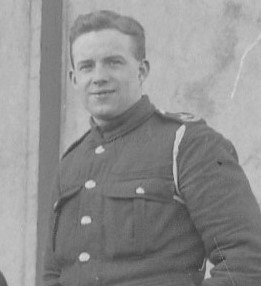
Mairi Featherstone visited the museum to see if we could find out a little about her grandfather, David Logan’s First World War service.
After a some investigation, it became clear that he had been in the Royal Field Artillery. On of the original postcards revealed that he had been at Scotton Camp (it is inscribed with “Cooks and Waiters, Sergeant’s Mess, Scotton Camp, Yorks 19/6”), which was eventually absorbed into Catterick Camp during the war. No 5 TF Artillery Training School was based at Scotton Camp in 1915, which is the most probable reason for his time there.
David’s medal card shows that he was in France by May 1915. There are two regimental numbers on his medal card, an early number, 971 referring to the Territorial Force RFA and a second reference 645569.
645569 Gunner David Logan was entitled to the 1915 Star, the British War Medal and the Victory Medal at the end of his war service.

An unusual group photograph – David is on the right

David Logan at Scotton camp
Explore more memories from the ribbon
-
Captain Thomas Ernest Dufty
Captain Thomas Ernest Dufty 5th Battalion Yorkshire Regiment Captain Dufty was born in on the 30th of June 1880. His father was Arthur Richard Sykes Dufty and his mother was called Katie. He was educated at Pocklington Grammar School. He joined the 5th Battalion in 1912 and became a lieutenant in June 1913. Prior to this his profession was as a banker and manager of the Bridlington branch of the London Joint Stock Bank. Dufty was promoted to Captain on the 18th of April 1915. He was reported as killed in action on or about the 19th of May 1915 (killed by a shell). His Battalion had been deployed to Sanctuary Wood (1.9 miles east of Ypres). He left a widow, Beatrice, and a 4-year-old son Arthur Richard. He is buried at the Vlamertinghe Military Cemetery in Belgium and commemorated at the Manor Road Cemetery Scarborough.
-
Herbert John Friend
Researched by John Mills Herbert was born on the 16th June 1885 in India. He was baptised on the 8th July 1885 at St John’s Church in Meerut. He was the son of George Friend, a Lance Corporal in the Kings Own Scottish Borders. Nothing is known about Herbert’s childhood and early life. In fact the next that is known about Herbert is that he is a soldier with the Yorkshire Regiment. His service number, 9970, would indicate that he joined around December 1911 and was in the 2nd Battalion. He had been stationed at The Curragh at some point and while there he met his future wife Nora who lived nearby on the Harrison Estate in County Kildare. They were married on the 21st January 1916 while Herbert was home on leave from France. He attained the rank of Corporal on the 31st October 1914 and by October 1916 was a CSM. Herbert would survive the war and by 1919 he was part of the Expeditionary force sent to the Archangel area of Russia to assist the White Russians against the Bolsheviks. This campaign is well documented for the severe conditions and brutality. By September 1919 he was on his way home but in a poor state of health. Herbert and Nora settled in Reading and had two children, George and Enid. On the 14th January 1924 Herbert left the service’ He was given a presentation clock, the inscription reading ‘A token of esteem from members of the Mess…
-
Alfred W Salmon
Alfred was born around June 1882 at Thornaby near Stockton, the son of Thomas Salmon, a foreman brewer. Alfred would eventually become an assistant grocer at Leyburn. Here he courted Lizzie Chiltern. Lizzie’s brother James had joined the West Yorkshire Regiment and was killed in June 1917 aged 20. It would appear that they never married as Alfred’s attestation form, when he signed up, has him as unmarried. The 1911 census has Alfred living in Leyburn as a boarder to a widow Catherine Pearson, aged 70. He enlisted on the 8th April 1916 at Leyburn joining the 5th Battalion Yorkshire Regiment. By early 1917 Alfred had been wounded and was to spend the rest of 1917 and part of 1918 convalescing in England. He was discharged from the Army on the 15th April 1918, his rank being Lance Corporal. Alfred was now living in Waverley Terrace, Darlington. It was here that he died from pneumonia, exacerbated by his war wounds on the 16th February 1919 aged 36. Alfred was buried in Darlington West Cemetery.
